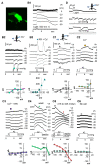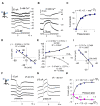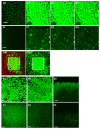Generators of Pressure-Evoked Currents in Vertebrate Outer Retinal Neurons
- PMID: 34067375
- PMCID: PMC8224636
- DOI: 10.3390/cells10061288
Generators of Pressure-Evoked Currents in Vertebrate Outer Retinal Neurons
Abstract
(1) Background: High-tension glaucoma damages the peripheral vision dominated by rods. How mechanosensitive channels (MSCs) in the outer retina mediate pressure responses is unclear. (2) Methods: Immunocytochemistry, patch clamp, and channel fluorescence were used to study MSCs in salamander photoreceptors. (3) Results: Immunoreactivity of transient receptor potential channel vanilloid 4 (TRPV4) was revealed in the outer plexiform layer, K+ channel TRAAK in the photoreceptor outer segment (OS), and TRPV2 in some rod OS disks. Pressure on the rod inner segment evoked sustained currents of three components: (A) the inward current at <-50 mV (Ipi), sensitive to Co2+; (B) leak outward current at ≥-80 mV (Ipo), sensitive to intracellular Cs+ and ruthenium red; and (C) cation current reversed at ~10 mV (Ipc). Hypotonicity induced slow currents like Ipc. Environmental pressure and light increased the FM 1-43-identified open MSCs in the OS membrane, while pressure on the OS with internal Cs+ closed a Ca2+-dependent current reversed at ~0 mV. Rod photocurrents were thermosensitive and affected by MSC blockers. (4) Conclusions: Rods possess depolarizing (TRPV) and hyperpolarizing (K+) MSCs, which mediate mutually compensating currents between -50 mV and 10 mV, serve as an electrical cushion to minimize the impact of ocular mechanical stress.
Keywords: TRPV; confocal microscopy; immunofluorescence; mechanosensitive channel; patch clamping; potassium channel; rod; temperature.
Conflict of interest statement
The authors declare no conflict of interests.
Figures





Similar articles
-
The Variety of Mechanosensitive Ion Channels in Retinal Neurons.Int J Mol Sci. 2024 Apr 30;25(9):4877. doi: 10.3390/ijms25094877. Int J Mol Sci. 2024. PMID: 38732096 Free PMC article. Review.
-
The co-expression of the depolarizing and hyperpolarizing mechanosensitive ion channels in mammalian retinal neurons.Front Med (Lausanne). 2024 Nov 13;11:1463898. doi: 10.3389/fmed.2024.1463898. eCollection 2024. Front Med (Lausanne). 2024. PMID: 39606631 Free PMC article.
-
Calcium-activated potassium current clamps the dark potential of vertebrate rods.Eur J Neurosci. 2001 Jul;14(1):19-26. doi: 10.1046/j.0953-816x.2001.01605.x. Eur J Neurosci. 2001. PMID: 11488945
-
Horizontal cell feedback regulates calcium currents and intracellular calcium levels in rod photoreceptors of salamander and mouse retina.J Physiol. 2009 May 15;587(Pt 10):2353-64. doi: 10.1113/jphysiol.2009.169656. Epub 2009 Mar 30. J Physiol. 2009. PMID: 19332495 Free PMC article.
-
First events in vision: the generation of responses in vertebrate rods.J Cell Biol. 1981 Aug;90(2):271-8. doi: 10.1083/jcb.90.2.271. J Cell Biol. 1981. PMID: 6116715 Free PMC article. Review. No abstract available.
Cited by
-
Retinal TRP channels: Cell-type-specific regulators of retinal homeostasis and multimodal integration.Prog Retin Eye Res. 2023 Jan;92:101114. doi: 10.1016/j.preteyeres.2022.101114. Epub 2022 Sep 24. Prog Retin Eye Res. 2023. PMID: 36163161 Free PMC article. Review.
-
TRPV4: Cell type-specific activation, regulation and function in the vertebrate eye.Curr Top Membr. 2022;89:189-219. doi: 10.1016/bs.ctm.2022.07.005. Epub 2022 Sep 2. Curr Top Membr. 2022. PMID: 36210149 Free PMC article.
-
Mechanosensitive ion channels in glaucoma pathophysiology.Vision Res. 2024 Oct;223:108473. doi: 10.1016/j.visres.2024.108473. Epub 2024 Aug 23. Vision Res. 2024. PMID: 39180975 Review.
-
Mechanism of barotaxis in marine zooplankton.Elife. 2024 Sep 19;13:RP94306. doi: 10.7554/eLife.94306. Elife. 2024. PMID: 39298255 Free PMC article.
-
The Variety of Mechanosensitive Ion Channels in Retinal Neurons.Int J Mol Sci. 2024 Apr 30;25(9):4877. doi: 10.3390/ijms25094877. Int J Mol Sci. 2024. PMID: 38732096 Free PMC article. Review.
References
Publication types
MeSH terms
Substances
Grants and funding
LinkOut - more resources
Full Text Sources
Research Materials
Miscellaneous

